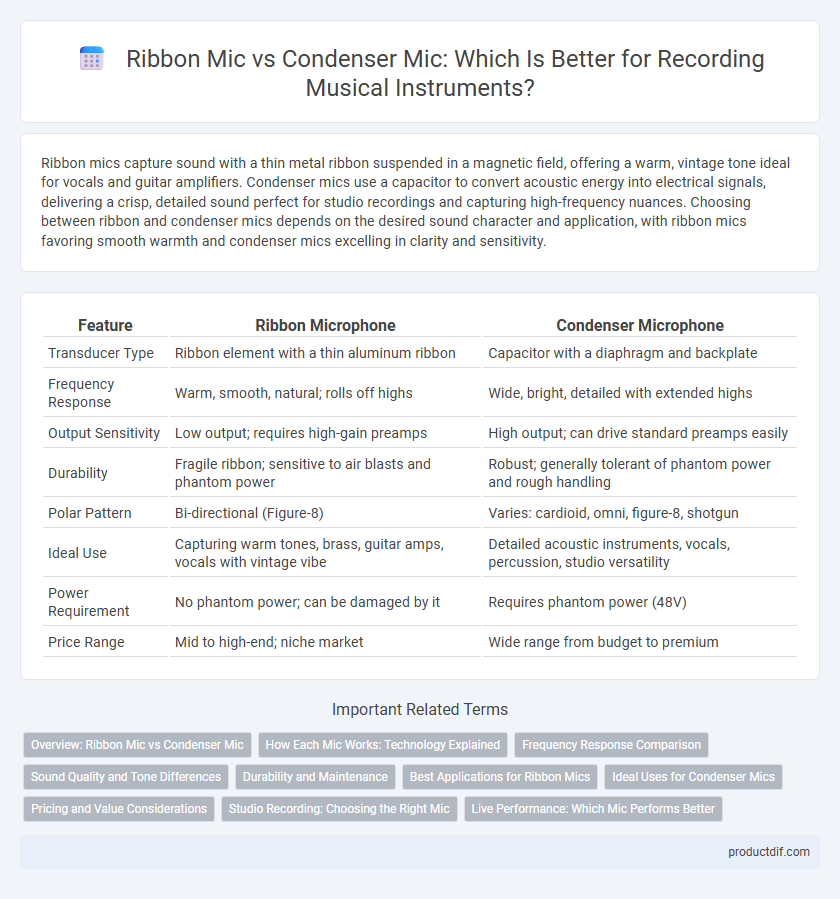Ribbon mics capture sound with a thin metal ribbon suspended in a magnetic field, offering a warm, vintage tone ideal for vocals and guitar amplifiers. Condenser mics use a capacitor to convert acoustic energy into electrical signals, delivering a crisp, detailed sound perfect for studio recordings and capturing high-frequency nuances. Choosing between ribbon and condenser mics depends on the desired sound character and application, with ribbon mics favoring smooth warmth and condenser mics excelling in clarity and sensitivity.
Table of Comparison
| Feature | Ribbon Microphone | Condenser Microphone |
|---|---|---|
| Transducer Type | Ribbon element with a thin aluminum ribbon | Capacitor with a diaphragm and backplate |
| Frequency Response | Warm, smooth, natural; rolls off highs | Wide, bright, detailed with extended highs |
| Output Sensitivity | Low output; requires high-gain preamps | High output; can drive standard preamps easily |
| Durability | Fragile ribbon; sensitive to air blasts and phantom power | Robust; generally tolerant of phantom power and rough handling |
| Polar Pattern | Bi-directional (Figure-8) | Varies: cardioid, omni, figure-8, shotgun |
| Ideal Use | Capturing warm tones, brass, guitar amps, vocals with vintage vibe | Detailed acoustic instruments, vocals, percussion, studio versatility |
| Power Requirement | No phantom power; can be damaged by it | Requires phantom power (48V) |
| Price Range | Mid to high-end; niche market | Wide range from budget to premium |
Overview: Ribbon Mic vs Condenser Mic
Ribbon microphones capture sound using a thin aluminum ribbon suspended in a magnetic field, offering warm, natural tones ideal for recording vocals and instruments with a vintage character. Condenser microphones use a capacitor to convert acoustic energy into electrical signals, providing high sensitivity and detail, making them preferred for studio applications that demand clarity and accuracy. The choice between ribbon and condenser mics depends on the desired sound texture, sensitivity requirements, and recording environment.
How Each Mic Works: Technology Explained
Ribbon microphones use a thin aluminum ribbon suspended within a magnetic field to convert sound waves into electrical signals, capturing audio with a natural, warm tone ideal for vocals and instruments. Condenser microphones operate using a capacitor with a diaphragm that changes capacitance as sound waves cause it to move, providing a wide frequency response and high sensitivity for detailed recording. Ribbon mics excel in smooth, vintage sound reproduction, while condenser mics offer versatility and clarity suited for studio environments.
Frequency Response Comparison
Ribbon microphones typically exhibit a smooth, natural frequency response with a gentle roll-off in high frequencies, making them ideal for capturing warm, vintage tones in musical recordings. Condenser microphones offer a broader frequency response range, extending higher into the treble region, which provides increased detail and clarity for vocals and acoustic instruments. The choice between ribbon and condenser mics depends on the desired tonal quality, with ribbons favoring a mellow sound and condensers excelling in crisp, articulate audio reproduction.
Sound Quality and Tone Differences
Ribbon mics deliver a natural, warm sound with smooth high-frequency roll-off, capturing rich midrange tones ideal for vocals and brass instruments. Condenser mics provide a brighter, more detailed sound with extended high-frequency response, offering clarity and precision suitable for acoustic guitars and cymbals. The choice between ribbon and condenser microphones significantly affects tonal character and sound quality in recording environments.
Durability and Maintenance
Ribbon microphones are generally more fragile due to their thin metal ribbons, making them susceptible to damage from strong gusts of air and physical shock, which requires careful handling and regular maintenance. Condenser microphones feature robust diaphragm construction and often include built-in preamps, offering greater durability and less frequent servicing demands in professional and home studio environments. Proper storage, gentle cleaning, and humidity control can prolong the lifespan of both ribbon and condenser microphones.
Best Applications for Ribbon Mics
Ribbon microphones excel in capturing warm, natural tones and are ideal for recording brass instruments, guitar amplifiers, and string sections where smooth high-frequency response and detailed midrange are critical. Their figure-8 polar pattern offers excellent rejection of ambient noise, making them suitable for studio environments that require isolation and minimal room coloration. Ribbon mics are preferred for vintage and classic sound recordings, delivering a rich, textured audio quality that condenser microphones may not replicate as naturally.
Ideal Uses for Condenser Mics
Condenser microphones excel in studio environments where capturing detailed, high-frequency sounds is essential, making them ideal for vocals, acoustic guitars, and pianos. Their sensitivity and broad frequency response allow for precise reproduction of subtle nuances and transient sounds in musical instruments. These mics are preferred for recording environments with controlled acoustics to maximize clarity and minimize background noise.
Pricing and Value Considerations
Ribbon microphones typically cost more than condenser microphones due to their delicate construction and vintage appeal, impacting budget decisions for recording professionals. Condenser mics offer a wide price range, from affordable entry-level models to high-end options, providing flexibility for various studio setups. Evaluating value involves balancing audio quality, durability, and specific recording needs against initial investment and long-term reliability.
Studio Recording: Choosing the Right Mic
Ribbon microphones capture warm, natural sound with smooth high-frequency roll-off, ideal for vintage-style studio recordings and instrument miking like guitar amps and brass. Condenser microphones offer a broad frequency response and high sensitivity, making them perfect for detailed vocals, acoustic guitars, and piano recordings with clarity and precision. Selecting the right mic depends on the desired tonal quality; ribbon mics excel in warmth and smoothness, while condenser mics provide brightness and detail.
Live Performance: Which Mic Performs Better
Ribbon microphones excel in live performance environments by delivering warm, natural sound with smooth high-frequency response, reducing harshness often encountered on stage. Condenser microphones offer greater sensitivity and broader frequency response, capturing detailed vocals and instruments but can be prone to feedback in loud settings. Choosing the ideal mic depends on the specific live sound requirements, with ribbon mics favored for vintage warmth and condensers preferred for clarity and presence.
Ribbon mic vs Condenser mic Infographic

 productdif.com
productdif.com